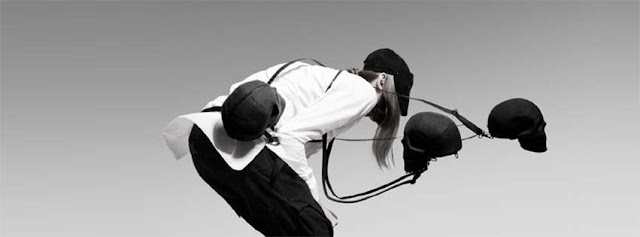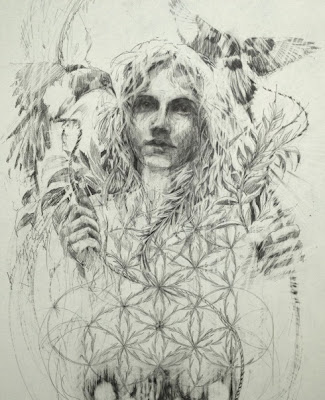The fashion industry is in crisis. Groundbreaking revelation? No, because it always has been. We just don’t see what lurks beneath the beautiful veneer of an exquisite garment flourishing on a catwalk blinded by camera flashes and pretentious celebrities. We don’t see the crushing ballast threatening the very heartbeat of the designer’s creativity. As a label becomes more successful, it becomes greedier – whilst the smaller designers clasp to even remain buoyant on the restless tide of a mercurial and fickle fashion climate. Ultimately, most companies will sink, whilst some of the higher fliers inevitably buckle under the drudging demands to deliver season after season (the recent disgrace of one leading designer and the tragic death of another is perhaps still an open wound in our minds here).
A pretty bleak outlook on the industry. Do you have the will to read on? If I were to paint a picture depicting the state of the industry, it would be a dripping black canvas, or perhaps if I was feeling a little creative, an illustration of one of Riccardo Tisci’s Givenchy Rottweilers choking on a fistful of banknotes shoved through its gnashing jaws. At least it’d be honest. Because it is honesty which is becoming scarce to find in a time where designers are really feeling the pinch of the moneymen. Ultimately, it is they who make final decisions – increasingly forcing designers into banal submission of those who hold the cash at the expense of their integrity. The excruciating reality is that financiers do not understand – nor do they care – about the ‘art’ of fashion.
Whilst the buyers may be laughing, the creatives are dying inside: any passionate designer who obsesses over their craft is at their core a tortured artist, with surprisingly little concern for the financial rewards. I, like many designers I have spoken with, will tell you that they design not for ‘the consumer’ but for themselves – as it should be. So the minute a creative is forced to churn out something for sake of the next dollar, there’s a dishonesty and discredit there. He has, against sheer and unrelenting brute force, surrendered to the probing corruption of the businessman. Alas, honesty comes under intolerable strain.
But SS13 is set to offer us at least a few saviours who shine as both rebellious, reckless revolutionaries and positive pioneers, ferociously committed to the truth of their artistic philosophies in the sorry face of the industry. They illustrate a fresh and brutal ‘all’s-not-lost’ attitude that truly quenches an arid thirst for something redemptive. The first is Boris Bidjan Saberi – a designer who’s very name sounds like a nomadic ninja from the cavernous depths of a future sent back through time to rescue us from a moral/financial recession. Saberi is known for his unmistakably brutal grunge; his hard-edged, raw aesthetics and so-called “dark hip-hop”.
His extreme manipulation of fabrics ventures into the realm of the haunting unknown and to the point of chemical experimentation. Saberi is more than a clothes designer: he evokes a mood, a narrative, an atmosphere inspired by real life crises and thoughtful reactions to the world around him. Just a glance at his clothes tells you he has zero intention of abiding to any imaginary “rules” prescribed by the pressure to “make figures”. It’s admirable, intimidating, and necessarily confrontational. Saberi owns the space. Owns his collection. Extreme plunging drapes and oversized mesh hoods and masks articulate this attitude that refuses to be compromised.
For SS13, Saberi retains his monochromatic palette but brings us for the first time a more structured and polished collection, featuring a marriage between extreme tailoring and highly adventurous sportswear. If his previous collections were a bunch of teenage outlaws, SS13 is a matured crew of veteran gangsters, glued together and ready to resist as a community not divided by the invasion of the moneymen. There’s an understated, minimalist thread going through SS13 which keeps a sophisticated angst bubbling beneath the surface – but it’s still there: not to be messed with.
Most memorable for me is the tight tailoring with discrete slit vents on the jacket blazers which hark back to Saberi’s deconstructive style without being too showy. In addition, the new angular waistcoats created a superb, futuristic silhouette around the architecture of the male form. Also striking were the paneled asymmetric shirt collars, and the pure all-white looks were a jarring shock to the system: “purity” is perhaps the last word with which we’d be accustomed to describe Saberi’s aesthetic. Sort of like a schizophrenic clash between the Black and White Swan.
Next, Aitor Throup. Now here's someone who diverges between the role of commercial designer and that of artist, imprinting his unique social comment on the identity of the industry in the most visceral and 3-dimensional way. Saberi’s nomadic style has always been conjured by mesh layering and other transparent fabrics, creating a strong, cocooning sense of protection – but Throup takes that a step further with intriguing concepts of body armour and physical encasing.
The London SS13 collection saw an eerie set of highly dense, scrunched up wire mannequins suspended from the ceiling, in addition to these oddly playful, accessorised skulls, candidly slung over the shoulders of mannequins like trophies from Predator’s latest killing spree. Interestingly, it was reminiscent of Saberi’s SS09 disturbing collection which featured white-clad models suspended from the ceiling by chains. Sounds like I’m trying to promote some kind of sadistic suicide couture.
Like Saberi, Throup is an artist – attempting at once to capture the psyche of the modern man. He inhabits an intense, utterly opposing world that would have financiers so groggy with confusion and incomprehension that the only option would be to let the man continue doing his own thing. His signature anatomy trousers absolutely propel Throup beyond the exhausted parameters of fashion trends, with a clear respect for the human body and it’s meticulous formation.
There’s an anthropomorphism to his drawings, too, with irresistible sniffs of Giger present in his manipulation of the human form through a highly conceptual and deformative - but also reconstructive, lens. It’s like he’s remoulding the overused silhouette, whilst also attuning himself to the anxiety of the industry’s pangs – of which there are many.
There’s an anthropomorphism to his drawings, too, with irresistible sniffs of Giger present in his manipulation of the human form through a highly conceptual and deformative - but also reconstructive, lens. It’s like he’s remoulding the overused silhouette, whilst also attuning himself to the anxiety of the industry’s pangs – of which there are many.
Throup is by far one of the most important breakthroughs of the year, deriving his demand – like Saberi – from his mysteriousness – the kind that has made an international success of Hussein Chalayan despite flickering on and off the radar. That sense of the unknown and the unpredictable – relevant both in the collection’s aesthetic but more intriguingly in the uncertainty between the artist’s presence and absence – is what restores the designer’s integrity and in turn the market’s hunger for more.
















































